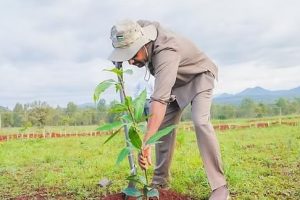
BY STAFF REPORTER
Ethiopia has been striving to enhance green economic development in various ways. One of the outstanding efforts of the country in green development is the massive afforestation campaign of the “Green Legacy Initiative”
The initiative which started in the summer of 2019 has a plan to transplant about 20 billion seedlings of various varieties in five years. So far the campaign has enabled the transplantation of about 17 billion tree seedlings in various parts of the country.
As the seedlings sprouted the campaign has shown its contribution to the prevention of the climate change impacts. Yet despite all these efforts, some parts of the country are facing severe consequences of climate change. For instance recently, some localities in Borena and Guji zones of Oromia State are facing severe drought.
While the country strives to mitigate the impacts of climate change through its domestic endeavor it is also important to note that the efforts of preventing climate change and mitigating the impacts should be assisted by the relentless efforts of the world.
In a recent event to launch low lands climate adaptation project, Oromia state Environment, Forest and Climate Change Commissioner Seifedin Mehadi said, “Climate change is causing clear and imminent impact against the country. People are facing challenges from unpredictable changes like flood drought, loss of productivity, famine, alien pests and diseases. The lowlands of the country are primarily vulnerable to the problem.
According to UNEP, while Africa has contributed negligibly to the changing climate, with just about two to three percent of global emissions, it stands out disproportionately as the most vulnerable region in the world. This vulnerability is driven by the prevailing low levels of socioeconomic growth in the continent. While climate change is global, the poor are disproportionately vulnerable to its effects.
This is because they lack the resources to afford goods and services they need to buffer themselves and recover from the worst of the changing climate effects. This is the case in Africa. To this end, UNEP Africa office’s climate change work in the region focuses on supporting countries to put in place a structure for implementing their climate action commitments – popularly known as Nationally Determined Contributions (NDCs) in a manner the meets leading socioeconomic priorities – food security, creation of income and enterprise opportunities for the youth and economic expansion.
Climate change is real and happening now. The impact of climate change is becoming imminent threat not only in Ethiopia but also in many African countries at the moment. The effects of climate change such as rising temperature and changes in precipitation are undeniably clear with impacts already affecting ecosystems, biodiversity and people. In both developed and developing countries, climate impacts are reverberating through the economy, from threatening water availability to sea-level rise and extreme weather impacts to coastal regions and tourism. In some countries, climate impacts affect the ecosystem services that communities are largely dependent upon, threatening development and economic stability. Future impacts are projected to worsen as the temperature continues to rise and as precipitation becomes more unpredictable.
Because of the lack of economic, development, and institutional capacity, African countries are likely among the most vulnerable to the impacts of climate change (IPCC, 2001). Climate change impacts have the potential to undermine and even, undo progress made in improving the socio-economic well-being of East Africans. The negative impacts associated with climate change are also compounded by many factors, including widespread poverty, human diseases, and high population density, which is estimated to double the demand for food, water, and livestock forage within the next 30 years (Davidson et al., 2003).
Climate change in Africa is an increasingly serious threat for Africans as Africa is among the most vulnerable continents to climate change. Anthropogenic climate change is already a reality in Africa, as it is elsewhere in the world. According to the Intergovernmental Panel on Climate Change, the vulnerability of Africa to climate change is driven by a range of factors that include weak adaptive capacity, high dependence on ecosystem goods for livelihoods, and less developed agricultural production systems.
Climate change will increasingly impact Africa due to many factors. These impacts are already being felt and will increase in magnitude if action is not taken to reduce global carbon emissions. The impacts include higher temperatures, drought, changing rainfall patterns, and increased climate variability. These conditions have a bearing on energy production and consumption. The recent drought in many African countries, which has been linked to climate change, adversely affected both energy security and economic growth across the continent.
To reduce the impacts of climate change on African countries, adaption measures are required at multiple scales – ranging from local to national and regional levels. The first generation of adaptation projects in Africa can be largely characterised as small-scale in nature, focused on targeted investments in agriculture and diffusion of technologies to support adaptive decision-making. More recently, programming efforts have re-oriented towards larger and more coordinated efforts, tackling issues that spanning multiple sectors.
Improved weather forecasting technology in sub-Saharan Africa is important to inform the response to climate change, to aid decision-making associated with adaptation to climate change for example.
This is achieved through driving climate and environment action as an investment opportunity and a source of socioeconomic improvement that is championed in high level member states policy forums like the African Ministerial Conference on the Environment (AMCEN) and the United Nations Environment Assembly (UNEA). This tactic is backed by science and results in knowledge for policy as well as project actions– that have been tested and validated in other countries. In this approach, mitigation and adaptation are considered as complementary, with mitigation interventions primarily in clean energy aligned to power adaptation mostly in land-based actions like agriculture. This is opposed to classical approaches where mitigation and adaptation actions are considered largely in standalone silos. This approach also aligns to ensure Article 7 and 9 of the Paris Agreement that call for “parity between mitigation and adaptation” is realistically achieved on the continent.
The Ethiopian Herald October 26/2021





